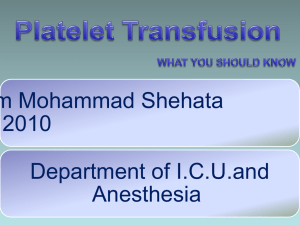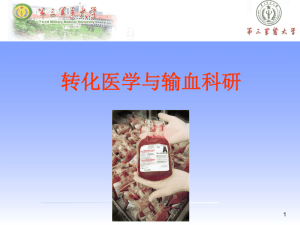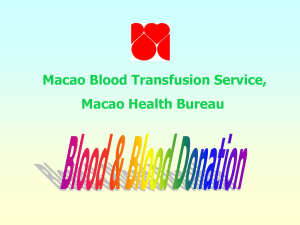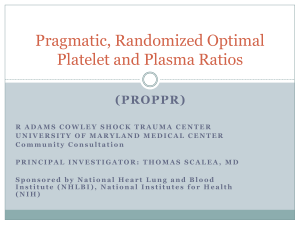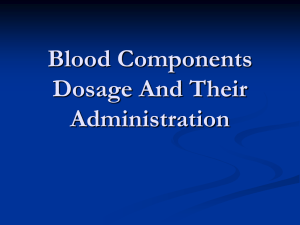Tom DeLoughery - Oregon Health & Science University
advertisement
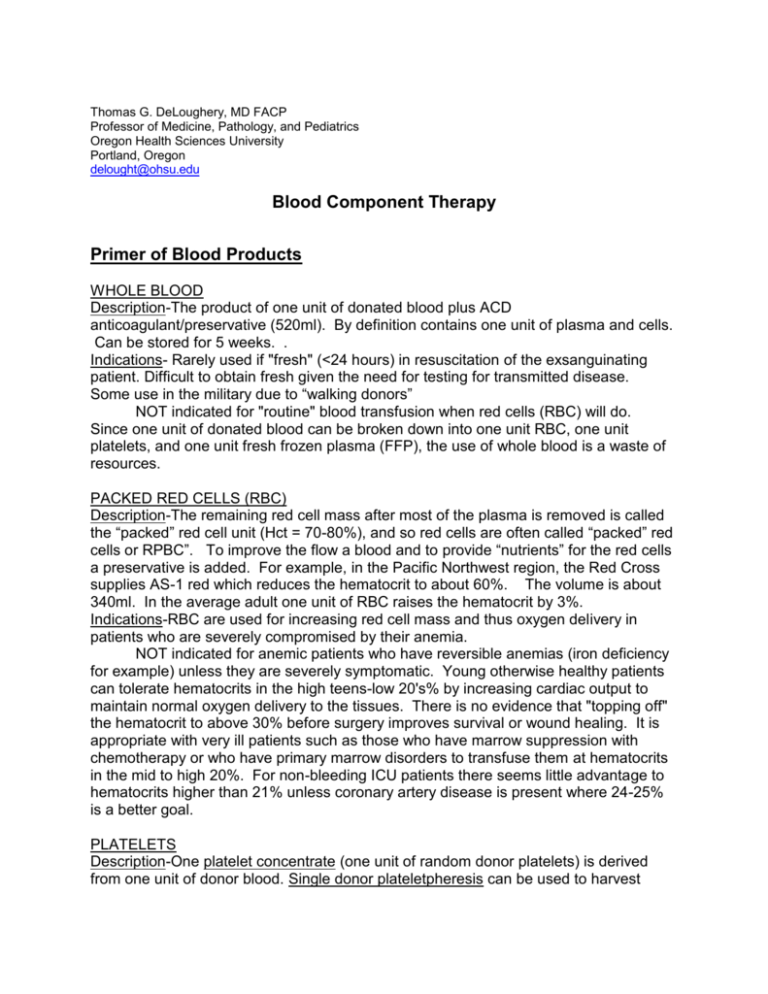
Thomas G. DeLoughery, MD FACP Professor of Medicine, Pathology, and Pediatrics Oregon Health Sciences University Portland, Oregon delought@ohsu.edu Blood Component Therapy Primer of Blood Products WHOLE BLOOD Description-The product of one unit of donated blood plus ACD anticoagulant/preservative (520ml). By definition contains one unit of plasma and cells. Can be stored for 5 weeks. . Indications- Rarely used if "fresh" (<24 hours) in resuscitation of the exsanguinating patient. Difficult to obtain fresh given the need for testing for transmitted disease. Some use in the military due to “walking donors” NOT indicated for "routine" blood transfusion when red cells (RBC) will do. Since one unit of donated blood can be broken down into one unit RBC, one unit platelets, and one unit fresh frozen plasma (FFP), the use of whole blood is a waste of resources. PACKED RED CELLS (RBC) Description-The remaining red cell mass after most of the plasma is removed is called the “packed” red cell unit (Hct = 70-80%), and so red cells are often called “packed” red cells or RPBC”. To improve the flow a blood and to provide “nutrients” for the red cells a preservative is added. For example, in the Pacific Northwest region, the Red Cross supplies AS-1 red which reduces the hematocrit to about 60%. The volume is about 340ml. In the average adult one unit of RBC raises the hematocrit by 3%. Indications-RBC are used for increasing red cell mass and thus oxygen delivery in patients who are severely compromised by their anemia. NOT indicated for anemic patients who have reversible anemias (iron deficiency for example) unless they are severely symptomatic. Young otherwise healthy patients can tolerate hematocrits in the high teens-low 20's% by increasing cardiac output to maintain normal oxygen delivery to the tissues. There is no evidence that "topping off" the hematocrit to above 30% before surgery improves survival or wound healing. It is appropriate with very ill patients such as those who have marrow suppression with chemotherapy or who have primary marrow disorders to transfuse them at hematocrits in the mid to high 20%. For non-bleeding ICU patients there seems little advantage to hematocrits higher than 21% unless coronary artery disease is present where 24-25% is a better goal. PLATELETS Description-One platelet concentrate (one unit of random donor platelets) is derived from one unit of donor blood. Single donor plateletpheresis can be used to harvest platelets. One unit of single donor (pheresis) platelets is equivalent to 5-6 platelet concentrates. One platelet concentrate can raise the platelet count by 5-7,000/uL. Platelets are mildly "stunned" while in storage and it takes 4 hours for transfused platelets to be fully functional in the circulation. A pool of five platelet concentrates contains enough plasma to be the equivalent of a unit of FFP (all coagulation factors except the labile V and VIII). HLA-matched platelets are single donor pheresis units that are from a HLA-matched donor. This product should only be ordered if there is evidence of HLA antibodies (see below). Remember always to check platelet counts 15 minute after platelet infusion. A poor 15 minute count may be indicative of HLA antibodies. A good 15 minute count but poor 24 hour count is more suggestive of consumption-fever, sepsis, drugs. etc., and not an indication for HLA matched platelets. Indications – For chemotherapy patients a transfusion trigger of 10,000/uL is appropriate. For patients who are bleeding or needing surgery 50,000/ul. One should order "single-donor plateletpheresis product" when giving patients platelets. Although not always available, use of this product will expose the patient to one donor instead of 6 – 8 and have the benefit of being leukodepleted. NOT indicated for stable thrombocytopenic patients with platelets counts over 10,000/uL. Also if platelets are given to patients with thrombotic thrombocytopenic purpura it may worsen the disease. Platelet alloimmunization Patients exposed to cells with different HLA types will develop antibodies to HLA antigens. This is most common in patients who have received previous transfusions of blood that is not leukodepleted, or patients who have been pregnant. Since platelets carry class I HLA antigens they will be rapidly destroyed by HLA antibodies. In the past, patients who were transfused for aplastic anemia or myelodysplasia as many as 90% became HLA immunized. Nowadays the incidence is less but can be seen in patients previously pregnant or transfused. Patients who have developed HLA antibodies usually respond better to platelets matched for HLA antigens. Unfortunately some patients will either be a rare HLA type or so heavily immunized that they will not respond to any platelet transfusion. The importance of alloimmunization centers on two concepts - recognition and avoidance. Patients with HLA antibodies will often fail to have an increment of their platelet counts with transfusions. Thus patients who do not increase their count 15 minutes after the transfusion may have HLA antibodies. One can test for anti-HLA antibodies, since some patients instead have specific antiplatelet antibodies that will not respond to HLA matched platelets. In patients who are planned to undergo transplant or aggressive chemotherapy that have been pregnant or previously transfused it is wise to check antiHLA antibodies so one can plan their transfusion needs. The evidence suggests that it is transfused white cells that are responsible for initiating the anti-HLA response. Trials have shown that giving leukodepleted blood products may reduce the incidence of alloimmunization, so patients who are not HLA alloimmunized should receive only leukodepleted products. Bleeding in the Platelet Refractory Patient Bleeding in patients who are refractory to platelet transfusion presents a difficult clinical problem. If patients are demonstrated to have HLA antibodies, one can transfuse HLA-matched platelets. Unfortunately, platelet transfusions are ineffective in 20 - 70% of these patients. Platelets are distributed as HLA-matched if they match even on one HLA locus but only the 3-4 loci match are effective. Since some loci are difficult to match effective products may be unavailable. As many as 25% of patients have anti-platelet antibodies in which HLA-matched products will be ineffective. In the patient who is totally refractory to platelet transfusion, consider drugs as an etiology of antiplatelet antibodies (especially vancomycin). Use of antifibrinolytic agents such as epsilon aminocaproic acid or tranexamic acid may decrease the incidence of bleeding. "Platelet drips" consisting of infusing either a platelet concentrate per hour or one plateletpheresis unit every 6 hours may be given as a continuous infusion. For life-threatening bleeding rVIIa may be of use. GRANULOCYTES Description-Granulocytes are harvested by leukopheresis. 1010 granulocytes are the aimed for yield for each donor. The harvesting procedure can take three hours and is associated with some minor risks to the donor (e.g., citrate toxicity). Indications-Very limited. Can be useful in the neutropenic patient with a documented bacterial infection in whom the leukocyte count is not expected to recover in the near future. Mainly used with small children. NOT indicated for most neutropenic patients especially in the era of hemopoietic growth factors. FRESH FROZEN PLASMA (FFP) Description-Derived from one unit of donated whole blood. Average volume is 225ml. One unit of FFP can raise coagulation factor levels by 5-8% and fibrinogen by 13mg/dl in the average patient. Remember it can take about 20-30 minutes to thaw FFP. Indications-Limited. Should only be used when there is a documented coagulation defect that can be corrected by a reasonable amount of FFP: 1) Factors V, XI deficiency 2) Disseminated intravascular coagulation 3) Reversal of warfarin 4) Massive transfusions NOT indicated for most of the purposes it is used for. FFP is often used as a "Super Glue" for any type of bleeding or any type of abnormality in coagulation testing (e.g. slightly prolonged PT). This is both a waste of product and needlessly exposes the patient to viral diseases. Also transfusion of FFP is not effective at reversing minor elevations of the INR (1.3-1.8) Studies have shown use of FFP is associated with multiorgan system failure and lung injury. CRYOPRECIPITATE Description-Cryoprecipitate is derived from one unit of fresh frozen plasma that is thawed at 4 degrees C. The precipitate is resuspended with 10ml of saline or FFP, and re-frozen for storage. One unit contains at least 150mg of fibrinogen and 80 units of factor VIII, along with von Willebrand factor. Cryoprecipitate takes about 20 minutes to thaw. Indications-Cryoprecipitate is useful to quickly raise the fibrinogen level in patients with DIC or massive transfusion with hemodilution. It is third line therapy in the treatment of Type 1 von Willebrand disease and is second line therapy of therapy in patients with other types of von Willebrand disease. Currently Humate-P is the preferred replacement product for von Willebrand disease. Cryo can be used as a source for factor VIII for hemophiliacs but the preferred product for these patients is the superpure factor VIII concentrates. Cryo can also be used to shorten the bleeding time of uremic patients. Summary Blood Component Whole blood (autologous or directed donations) Red cells (AS-1) Note: these are not “packed” red cells. Packed red cells have a Hct of 70-80% Platelet concentrate Platelet pheresis Fresh frozen plasma Cryoprecipitate Contents RBC and plasma. WBC and platelets not viable after 24 hr. Factors V and VIII significantly decreased after 2 days. Hct 35%. 450mL blood and 63 Ml CPDA-1 anticoagulant RBC with about 25 mL of plasma and 100 mL of saline and additive solution (adenine, mannitol). Hct 60% Volume 520 Ml Shelf Life 35 days 4o C 340 mL 42 days 4o C Platelets (5.5 X 1010); some WBC; 50 mL of plasma, a few RBC (Hct < .005) Platelets (3.5 X 1011); some WBC; 300 mL of plasma, a few RBC Plasma proteins, all coagulation factors, complement. 150 mg of fibrinogen , at least 80 units of factor VIII, von Willebrand factor, factor XIII, fibronectin, ADAMTS-13 50 mL 5 days 20o C 5 days 200 C 1 year-18o C 1 year-18o C 300 mL 225 mL 15 mL (Table created by Dr Lynn Boshkov) Complications of Transfusions HEMOLYTIC REACTION Hemolytic reactions had two varieties-immediate and delayed. The immediate reaction is heralded by fevers, hypotension, back pain and oliguria. In severe cases DIC may occur. Most often this is due to transfusion of ABO incompatible blood. This is the most common cause of death related to transfusion and almost always a result of errors in correct identification of the patient. The delayed reaction is marked by lack of expected rise of hematocrit, fevers, Coombs-positive hemolytic anemia, and jaundice. Reactions are due to recipient antibodies attacking donated RBC's resulting in release of hemoglobin and red cell membrane-antigen complexes. These complexes are believed to lead to the hypotension, etc. Treatment is by immediately stopping the transfusion, notifying the blood bank, vigorous IV hydration to keep the urine output over 100cc/hr, and supportive therapy. FEBRILE REACTIONS Many patients will get a febrile reaction after the transfusion starts. This is most often due to the presence of leukocyte debris and cytokines in the donated blood. Patients who have had febrile reaction should get future transfusion either with blood delivered through leucopoor filters or blood leukodepleted at blood center. Since transfusion reactions present with a similar clinical picture, all patients with fever during transfusion need a transfusion reaction work-up. TRANSFUSION RELATED ACUTE LUNG INJURY (TRALI) One rare complication of transfusion is noncardiac pulmonary edema. The typical picture is hypoxemia, fever, bilateral infiltrates and hypotension developing 2-6 hours after blood is given. Ventilatory support is often required. Recovery is usually rapid (24-48 hours) and complete. It is felt to be a form of ARDS caused by the presence of HLA antibodies in the donor serum leading to destruction of host granulocyte and activation of the complement system leading to lung injury. Another etiology is transfusion of preformed cytokines that lead to endothelial damage. Treatment is supportive. Major differential diagnosis is simple volume overload from aggressive transfusion. TRANSFUSION RELATED GRAFT VS HOST DISEASE (TGVH) Rare but deadly. Occurs when donor lymphocytes attack the blood recipient. Very rare in the normal blood recipient unless the donor and recipient share a HLA haplotype. TGVH is reported in blood recipients who are immunosuppressed- mainly patients with Hodgkin's disease and leukemia. Strangely enough TGVH does not occur in AIDS patients. Symptoms are an erythematous rash that may progress to epidermal toxic necrolysis, liver dysfunction and pancytopenia. TGVH is prevented by radiating blood products to at risk patients with 2500-3500 rads. Directed blood donation from all blood relatives should also be radiated. TGVH cannot be prevented by leucopoor blood! IRRADIATED BLOOD PRODUCTS, LEUKODEPLETED BLOOD AND CMV NEGATIVE BLOOD Irradiation of blood is performed for only one reason: to prevent transfusion-associated graft-versus-host-disease (TA-GVHD). Patients with HIV infection do not get TA-GVHD and should not receive irradiated blood. PATIENTS WHO SHOULD RECEIVE IRRADIATED BLOOD PRODUCTS ABSOLUTELY PROBABLE BMT RECIPIENTS HEMATOLOGICAL MALIGNANCIES OTHER THAN HODGKIN'S DISEASE CONGENITAL IMMUNE DEFICIENCIES PATIENTS RECEIVING AGGRESSIVE CHEMOTHERAPY INTERUTERINE TRANSFUSION TRANSFUSION FROM RELATIVES HODGKIN'S DISEASE (EVEN IN REMISSION!) Infectious Complications Blood is screen for many infections by both antigen testing and PCR testing for viral genome. However, there is still a window period where patients can be infective accounting for the residual risk of infections. This is ~ 11 days for HIV, ~12 for hepatis B and ~56 for hepatitis B. Disease screen for: hepatis B, hepatitis C, HIV, HTLV, syphilis, and west Nile virus. Risk of Viral Infections per unit Hepatitis B: 1:150,000 Hepatitis C: 1:2,000,000 HIV: 1:2,000,000,000 HTLV: 1:650,000 References: Abdel-Wahab OI, Healy B, Dzik WH. Effect of fresh-frozen plasma transfusion on prothrombin time and bleeding in patients with mild coagulation abnormalities. Transfusion. 2006 Aug;46(8):1279-85 Hod E, Schwartz J.. Platelet transfusion refractoriness. Br J Haematol. 2008 Jul;142(3):348-60. Murad MH, Stubbs JR, Gandhi MJ, Wang AT, Paul A, Erwin PJ, Montori VM, Roback JD.The effect of plasma transfusion on morbidity and mortality: a systematic review and meta-analysis. Transfusion. 2010 Jun;50(6):1370-83. Sihler KC, Napolitano LM.Complications of massive transfusion. Chest. 2010 Jan;137(1):209-20 Slichter SJ. Evidence-based platelet transfusion guidelines. Hematology Am Soc Hematol Educ Program. 2007:172-8 ..
